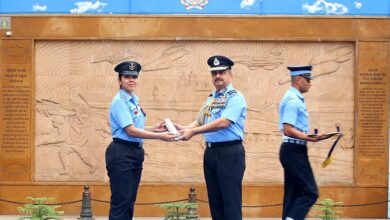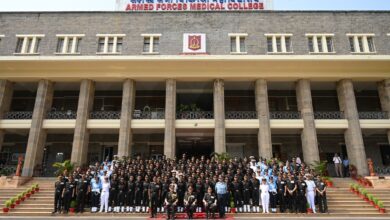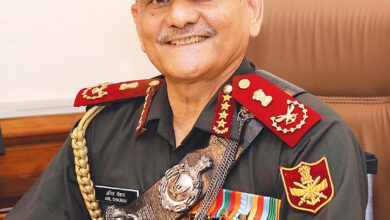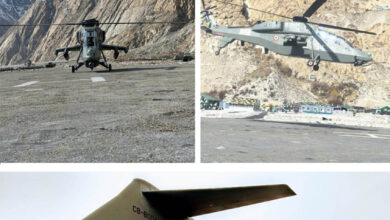IAF Set to Operate Formidable Apache Helicopters and Rafale MMRCAs

New Delhi. The Indian Air Force (IAF) is set to operate the new generation Boeing Apache attack helicopter from September, and Dassault Aviation’s Rafale Medium Multi Role Combat Aircraft (MMRCA) from around May 2020.
It is after a few decades that IAF is getting access to flying machines with advanced radars and precision weapon systems, and the induction of these two new generation combat helicopter and aircraft will formidably boost its offensive capability.
The Apache is actually a flying tank, and some of the machines with IAF will also be equipped with Lockheed Martin’s Longbow radar and Hellfire missile with capability to locate and delete hostile targets in thick jungle foliage. According to Air Vice Marshal Rajesh Isser, “the Apache is a dream-machine, incorporating the latest in technology and concepts in warfighting and conflict-management across the spectrum.”
The Apache, also known as a tank killer, played an effective role in the 1991 Gulf War. In the Operation Desert Storm then, the US Army used this helicopter in combination with US Air Force’s A 10 Warthog to decimate the Iraqi armour formations.

I had a chance to see and – enthusiastically like a boy – touch and feel the helicopter when it was brought to the Dubai Air Show in November 1991 after the liberation of Kuwait. A US Army officer explained some of the machine’s features, including the bullet proof cockpit shell, made of Kevlar and composites to protect the pilots. Later, in the recent years, I had another chance to closely see the Apache’s Mesa production facility, courtesy Boeing.
Rafale has proved itself in Syria where the UAE Air Force deployed it for precision strikes.
Notably, IAF has been asking for new machines for the last three decades for periodic and planned replacement of its older aircraft, and it’s only now, in the recent years, that aircraft of different types, combat and transport helicopters as well as aircraft have started coming.
IAF’s best bet yet otherwise has been the heavy Russian Su 30 MKI, which is very potent for long range strikes and delivery, but like any other air force, IAF needs smaller, multirole Medium and Light combat jets which are equipped with modern sensors and missiles and are also cheaper to operate to limit costs.

India’s own HAL Light Combat Aircraft (LCA) Tejas is now maturing in technology and updated variants should be available within the next few years in addition to those with Final Operational Clearance (FOC) now with IAF.
All other combat aircraft in IAF’s inventory were acquired between 30 to 45 years back, and at one time, in 2004, I had written in a report in The Tribune that “IAF is roaring for jet-speed at the Ministry of Defence” for both the combat and transport aircraft.
Besides the Apache and Rafale, IAF has now also got 15 heavy lift Boeing CH 47F Chinook helicopters, 11 C 17 heavy airlifters and 11 Lockheed Martin C 130J Super Hercules for Special Ops. One more C 130J is due to replace the one lost in a crash during training. That will complete IAF’s inventory of this aircraft to 12.
As for the combat jets, MMRCAs or MMRCA-plus, even now, IAF has on order only 36 Rafales while the requirement is for 400 of this type as most of its aircraft are old, mostly Soviet vintage Migs, whose phase-out is postponed every now and then.
There have not been much options so far, but there is a process on now for selection and progressively indigenous manufacture of 114 MMRCAs and some hope on the skyline. IAF had invited all the six contestants in the aborted 2007 tender to come back in the competition, relaunched last year.
Defence Minister Rajnath Singh and Chief of Air Staff Air Chief Marshal BS Dhanoa will do the ceremonial induction of the Boeing Apache on September 3 at IAF’s Pathankot forward airbase. Later, they will fly to France for the ceremonial acceptance of the Rafale on September 20 at Dassault’s factory airbase in the picturesque wine country of Bordeaux in southwestern France.
Notably, while 8 Apaches are already available to IAF and its pilots have started flying them for training and operations, the Rafales will be available to IAF initially for training in France for six months, and their first lot of 6 to 8 should arrive in India in April or May. The French have trained some Indian pilots, engineers and technicians already, and they in turn are coordinating with French instructors to train more Indian pilots and technical staff.
Boeing should supply another four Apaches this year, and 10 more of the contracted 22 in 2020. A further lot of 6 for the Indian Army will follow. Half of IAF’s Apaches will be at Pathankot in the Western sector and the other half at Jorhat in the eastern sector. Boeing had trained some Indian pilots in the US before delivering the helicopters to IAF at its Hindon airbase on the outskirts of New Delhi.
It is the same pattern for the Rafales.
Dassault Aviation, the French manufacturer and integrator, will present two aircraft for ceremonial acceptance to Mr Rajnath Singh and Air Chief Dhanoa, and then, every month, one more aircraft will be handed over to the Indian team in France itself for training.
Once in India, the first lot will be deployed at IAF’s western India’s Ambala fighter base straightway for operational requirements. Dassault should deliver all the 36 contracted Rafales by 2022, and half of them will be located at the northeastern base of Hashimara.
Both these aircraft, the Boeing Apache AH 64E, and Omnirole Rafale –as the French have designated it – have India Specific Enhancements (ISEs) like better radars and sensors and connectivity to enable them to talk to one another and operate in tandem with various IAF air and ground assets.





